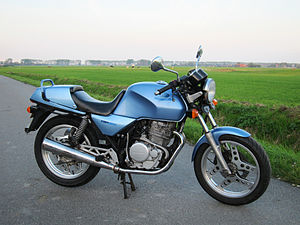Honda XBR500
This article needs additional citations for verification. (January 2020) |


The Honda XBR 500 is a 500cc Japanese sports motorcycle launched by Honda in 1985 and in response to the Yamaha SR500. It is powered by a single-cylinder four-valve engine with the valves arranged radially relative to the geometric centre of the hemispherical combustion chamber - (the Radial Four Valve Combustion Chamber, or RFVC) and actuated via intermediate sub-rockers. Displacing 498 cc (30.4 cu in) and producing 27 or 44 hp,[citation needed] the engine, having its origins in the Honda XR series off-road models, features a dry sump, the oil being stored in a separate tank below the seat. The steel-braided hoses connecting the oil tank to the engine (clearly visible at the right-hand side of the motorcycle) are a strong visual element.
The two exhaust valves enabled the motorcycle to be fitted with two separate exhaust systems. The motorcycle had both an electric start and a kick start.[1] On earlier models, the kick start was linked by a cable to an exhaust valve decompressor to reduce cylinder compression during manual engine starting; later examples incorporated the valve lifter with the camshaft. The fuel-efficient engine combined with the large fuel tank capacity (20 litres/5,28 US galls) provided the bike with a long range (typically well in excess of 200 miles) between refueling.[2]
XBR500s (F,G and H sub-types) were fitted with 18" Comstar wheels and tubeless tyres 100/90 front and 110/90 rear. The frame was of a single-downtube, dual-cradle design having a box-section swinging arm and conventionally sprung rear suspension. The last iteration, the XBR500SJ of 1988, was provided with wire-spoked wheels and tubed tyres. The XBR500 was a fine-handling machine with a wheelbase of 1,400 mm (55 in). A removable pillion seat cover was supplied to simulate a café-racer look, but Honda subsequently released a dedicated café racer version, the Honda GB500 TT, which featured some "classic British qualities", such as a solo seat, seat hump, wire wheels, two-into-one exhaust system and a fuel-tank with gold pinstriping.[1]
References[]
- ^ Jump up to: a b Hewitt, Sam (23 January 2019). "Turning Japanese: Honda's XBR500". Classic Motorcycle Mechanics. Retrieved 17 January 2020.
- ^ "7 brilliant big singles". Motorcycle News. 5 January 2016. Retrieved 17 January 2020.
- Honda motorcycles
- Sport bikes
- Motorcycles introduced in 1985
